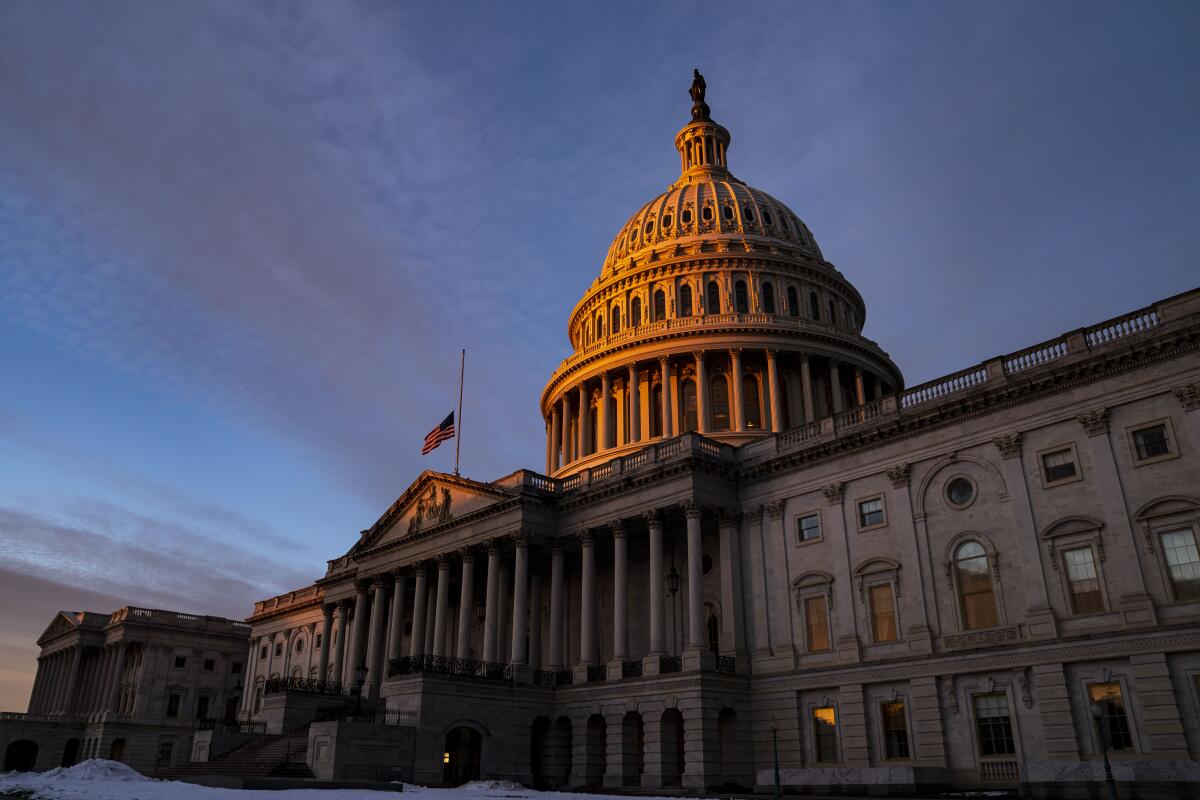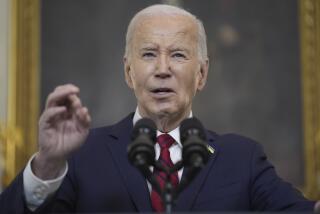House approves $13.6 billion in Ukraine humanitarian and military aid

WASHINGTON — The House on Wednesday approved a $1.5-trillion spending bill to keep the government’s doors open for the next six months as well as send $13.6 billion in humanitarian and military aid to Ukraine.
The bill includes more than $4 billion to assist Ukraine and others in Eastern Europe grappling with the millions of refugees fleeing the former Soviet republic after Russia invaded two weeks ago. Nearly $7 billion would backfill the transfer of U.S. military equipment to Ukraine and its allies, as well as cover the current and future deployment of American troops and equipment to defend NATO in the region. President Biden has said he would not send troops to Ukraine.
“We are becoming witness to one of the worst humanitarian crises we have seen in generations, which is why this bill provides $13.6 billion in humanitarian assistance, defense support and economic aid to help the Ukrainian people in their most desperate hour of need,” said House Appropriations Chairperson Rosa DeLauro (D-Conn.).
The bill was divided into two parts. The defense portion was approved overwhelmingly by members of both parties, 361 to 69. The remaining pieces had less support from Republicans but were approved 260 to 171, with one “present” vote.
The House also passed a bill to ban the U.S. importation of Russian oil and gas, a move designed to undermine Russia. It is an issue that has gained widespread support on Capitol Hill, driving the White House to announce this week that it would implement the ban itself.
“Tonight we are all Ukrainians,” said House Ways and Means Chairman Richard E. Neal (D-Mass.). “The more economic pain we inflict on [Russian President Vladimir] Putin, the more pressure he will feel to finally end this brutal campaign of terror on the Ukrainian people.”
The 2,741-page government spending bill attempts to avert a shutdown as soon as Friday evening. The bill now moves to the Senate, where leaders hope to approve it quickly, but they have a brief, stopgap spending bill on deck if needed to avert a shutdown.
Overwhelming bipartisan support for getting the Ukraine money out the door quickly enough to be effective propelled agreement on the broader bill. Congress hasn’t been able to enact a fulsome spending agreement since Oct. 1.
But even that bipartisan grease accomplished only so much. Democratic leaders scrambled on Wednesday to quell an uprising from their own members over another portion of the bill that would have directed $15.6 billion to combat the COVID-19 pandemic with additional vaccines and testing at home and abroad.
At the demand of Republicans who are skeptical of more COVID-19 spending, the funding was redirected from unspent money previously sent to states. Rank-and-file Democrats protested the clawback, forcing Democratic leaders to delete the whole COVID-19 funding provision in order to get the bill approved.
Underscoring the frenetic negotiations playing out in Speaker Nancy Pelosi’s office, Democrats held open a separate House floor vote for hours to eat up time so they could keep talking.
“Things are going exactly according to plan,” House Rules Committee Chairman Jim McGovern (D-Mass.) said sarcastically on the House floor as he withdrew the procedural measure on the original bill and announced that an altered bill would be introduced. “Everything is beautiful in its own way.”
Democrats had earlier hailed the funding as necessary to protect against emerging COVID-19 variants. Pelosi (D-San Francisco) called the removal “heartbreaking.”
House Democrats hope to enact their own $15.6-billion COVID-19 relief measure, but given the GOP’s reluctance to approve additional pandemic-related spending without offsets, a separate bill appears unlikely to be approved in the Senate. The House bill is partially paid for by returning unspent money to the Treasury. It does not rely on money from the state and local relief funds that prompted the controversy earlier in the day .
“What should be a slam dunk for Democrats as the party of science and public health has become yet another intraparty battle — and one that leaves the nation more vulnerable to future surges,” Rep. Jake Auchincloss (D-Mass.) said in a statement.
Also causing consternation was the brief amount of time lawmakers had to read the bill. The text came out early Wednesday with expectations of a midday vote — not enough time to comb through nearly 2,500 pages of text and more than a billion dollars in spending. Pelosi balked at questions about the brief timeline and the fact that even some Democrats were surprised at the COVID-19 funding structure.
“Let’s grow up about this, OK?” she said in response to a question about the late-night bill drop. “We’re in the legislative process. We have a deadline for keeping government open. We have a lively negotiation. It has to be bipartisan.”
The bill is stocked with other measures, including the first use of congressional earmarks — or money targeted at specific projects — since 2011. Among its other policies is the reauthorization of the Violence Against Women Act, money for Biden’s “cancer moonshot” to cure the disease and a boost in Pell Grants for students. It also calls for a plaque to be placed on the West Front of the Capitol honoring the police officers who responded to the Jan. 6, 2021, insurrection.
Democrats are relieved to see a 6.7% boost in domestic spending over the most recent spending agreements enacted under the Trump administration. Republicans countered with a 5.6% increase in defense spending.
More to Read
Get the L.A. Times Politics newsletter
Deeply reported insights into legislation, politics and policy from Sacramento, Washington and beyond. In your inbox three times per week.
You may occasionally receive promotional content from the Los Angeles Times.











